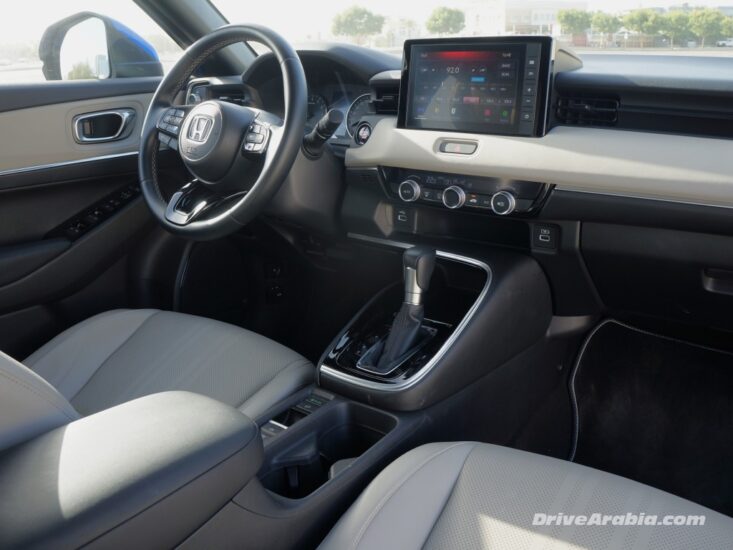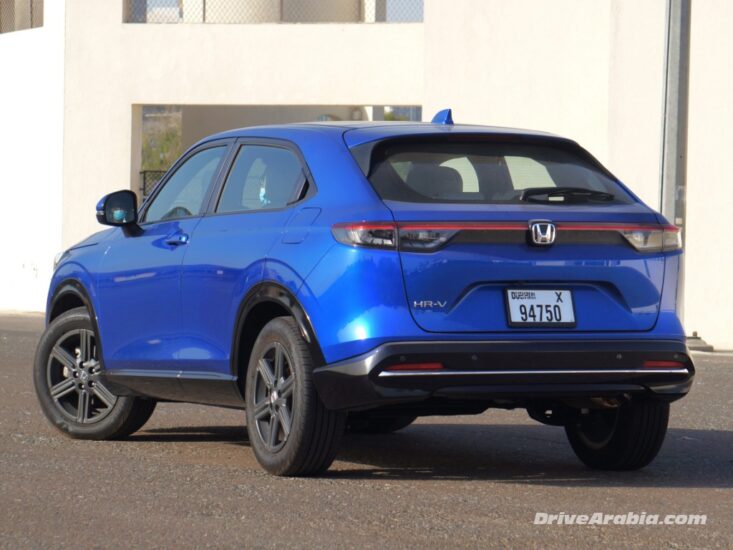2024 Honda HR-V
| The Good: – Handsome looks – Fair cabin space – Efficiency and driving feel |
The Bad: – Small boot space – Slightly pricier than rivals – Not very fast |
When it comes to small crossover SUVs, Honda has long been a formidable player in the segment. The first-generation CR-V was one of the first small crossover SUVs, leading to an explosion of a segment that has redefined cars forever. Back when cars and SUVs were two separate genres, who could’ve predicted that people prefer higher ride heights and wagon-style practicality while retaining a car-like driving feel and fuel economy. Now entire brands offer only crossover SUVs, including luxury ones. And Honda’s CR-V has grown over the last couple of decades, so there are now two smaller models below it, the smallest of them being the HR-V.
The current generation of the HR-V is a very handsome vehicle compared to the previous frumpy one. It is more of a tall hatchback than an SUV, about 200 mm taller in height, but only about 50 mm higher ground clearance than a Civic.
The boxier shape combined with a sharply sloping rear gives it a more attractive stance, complemented by full LED lighting front and rear as well as a unique iteration of Honda’s latest corporate grille. All models also get 17-inch alloy wheels, so there isn’t much visual differentiation between the three available trim levels except maybe for the front LED foglamps on our top version.

Stepping inside, the HR-V continues Honda’s new-found “clean” interior theme, with few dashboard lines and even fewer buttons. Soft-touch materials adorn large parts of the dashboard and front door panels, although some hard plastics still remain, as is standard in this class. Combined with light beige leatherette upholstery, the overall two-tone vibe is more upscale than in any previous small Honda.
Front and rear legroom as well as headroom is pretty good for a small crossover, better than several rivals. Honda’s penchant for storage is also evident in the HR-V, with numerous cup-holders and cubbies. However, the boot volume is small at 304 litres, far less than the previous model’s 448 litres.
But one of Honda’s standout features is the ingenious “Magic Seat” system. This allows the rear seat-bottoms to fold up cinema-style, providing a versatile cargo space for taller items. The rear seatbacks can also traditionally split-fold down, expanding useable cargo space to a more generous 1,274 litres.
In terms of tech, there are the basic modern commodities, such as a chunky 8-inch touchscreen on the dash for the 8-speaker audio system, Bluetooth, Apple CarPlay, 4.2-inch gauge-cluster display and USB charging ports even in the back. Additional features include an electric parking brake, wide-view rear camera, auto-dimming rearview mirror, smart key and a panoramic glass roof with manually-removable panels. The single-zone auto a/c takes time to cool the cabin after baking in the summer noon, but at least there are rear vents.
In terms of safety, our full-spec test car came with front, side and curtain airbags, ESP, hill-descent control, tyre-pressure monitor, rear-seat occupant reminder, driver attention monitor and the full Honda Sensing suite of active safety nannies, encompassing features like adaptive cruise control with low-speed following, collision mitigation braking and lane-keeping assist.

Under the hood, the HR-V is powered by a 1.5-liter 4-cylinder engine, making 119 hp at 6600 rpm and 145 Nm of torque at 4300 rpm. Mated to a CVT automatic, the HR-V has a downsized motor compared to the old model, probably because the slightly larger ZR-V now exists for those demanding more power and space.
There’s no getting around the fact that the latest HR-V is slow. The nearly 1300 kg did the full-throttle 0-100 kph sprint in 12.5 seconds during our summer test, and revved loudly all the way while doing so.
Still, the power feels more than adequate when trundling around the city. At highway speeds, the engine settles down to a negligible drone at 2000 rpm, but needs to be fired up hard for overtaking or tackling inclines.
Fuel efficiency is where the HR-V’s new motor finally shines, managing a respectable 7 litres/100 km (14.3 km/litre) during our time.
This iteration of the HR-V feels a little more dynamic in its cornering demeanour, even with slightly more ground clearance than the old model. Body roll is present but not overly so, while the limits of grip can be handled predictably. The steering is light, but weighted just right for the daily drive, while the brakes are adequate with linear brake-pedal feel, all of which are Honda hallmarks.
It also rides quite nicely, with chunky 215/60 Goodyear tyres on those 17-inch alloys. Road and wind noise start to become noticeable as you reach typical highway speed limits.
Being front-wheel-drive with no option for all-wheel-drive, the HR-V is strictly an on-road vehicle, even with the unusual presence of hill-descent control. Still, the higher ground clearance can come in handy when cutting across a gravel parking lot.
All in all, the HR-V still encapsulates a lot of Honda’s traditional commitment to practicality, economy and entertaining driving feel. While it has somehow lost power and boot space on its transition to the new model generation, this sub-compact crossover makes for a nice premium-feeling little runabout, albeit a bit pricier than some rivals.
Photos by Mashfique Hussain Chowdhury.
| Price Range: Dh 94,000-105,000 Current Model Introduced in: Body Styles: Engines: Transmissions: Setup: Suspension: |
Brakes: Front: discs Rear: discs Curb Weight: Length: Wheelbase: Top Speed: Test Acceleration 0-100 kph: Observed Test Fuel Economy: |
















There are no comments. Be the first!